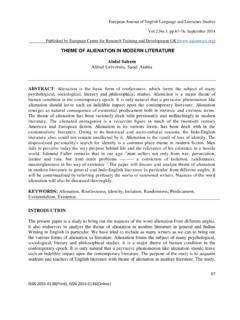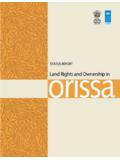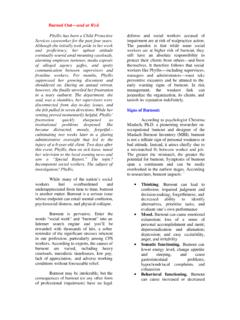Transcription of TRANSFORMATIVE MEDIATION A CRITIQUE This …
1 - 1 - TRANSFORMATIVE MEDIATION A CRITIQUE This article examines The Promise of MEDIATION from the perspective of a UK MEDIATION practitioner. It considers the contribution the book has made to the development of MEDIATION , both as a critical evaluation of existing practice and as an inspiration for practitioners, including the author. It describes three major critiques of The Promise of MEDIATION before considering the question: does TRANSFORMATIVE MEDIATION provide a coherent theory of MEDIATION ? In answering the question, the article considers what the urge for such a theory tells us about the stage of development of the MEDIATION profession.
2 Introduction When The Promise of MEDIATION was published in 1994, it immediately divided opinion. For some it was revelatory, setting out the true path for a profession that had lost its way in the thickets of the American justice system. For others it was delusional, confirming MEDIATION as a touchy-feely activity carried out by do-gooders with little practical relevance to actual disputes and, worse, foisting a goal of transformation onto unwilling customers. Whatever view is accurate, these debates have continued to rage (see for example Gaynier, 2005; Folger & Bush, 2005; Raines, 2005; Goodhardt, I.)
3 (2005). TRANSFORMATIVE MEDIATION : - 2 - Assumptions and practice. Journal of Family Studies, 11(2), 317-322.) In 2005 Baruch Bush and Joseph Folger published a second edition which proclaimed, In both these kinds of response, appreciative and critical, the first edition of our book has fulfilled the purpose we had in mind. (Bush & Folger, 2005, p. 2)1. In this article I propose to: describe the TRANSFORMATIVE MEDIATION model consider its impact on my own practice compare and contrast critical reaction to the model in the light of this, consider its contribution to the MEDIATION field The Promise of MEDIATION took a risk in making a theoretical contribution to a practical discipline.
4 I have chosen three critics who illustrate that, in some respects, it satisfies neither practitioners nor academics. This in turn raises the question: Does MEDIATION need an overarching theory? I will suggest that TRANSFORMATIVE MEDIATION , while considering both theory and practice, is at its strongest in articulating a set of principles for mediators, which can be characterised as the safest or least harmful stance available to conflict interveners. The Four Stories of MEDIATION 1 Where a page number is used alone, it refers to Bush, R & Folger, J (2005) The Promise of MEDIATION San Francisco: Jossey Bass - 3 - As The Promise of MEDIATION claims to be a corrective vision it is helpful to examine how Bush and Folger view the rest of the MEDIATION field.
5 Their first depiction is The Satisfaction Story . In this story, they claim, MEDIATION proponents describe its capacity to satisfy people s needs, emphasising its effectiveness in producing outcomes and contrasting its flexibility, informality and consensuality (p. 9) with the limitations of the legal process. The satisfaction story echoes the principled negotiation of Getting to Yes (Fisher and Ury, 1981) in stressing MEDIATION s ability to facilitate collaborative, integrative problem solving rather than adversarial distributive bargaining (p. 10). It also emphasises MEDIATION s potential to reduce both the emotional and economic cost of disputes.
6 This in turn produces private and public benefits: to individuals in resolving their disputes well with the minimum of fuss, to the state in dealing with costs and delays in the court system (p. 10). Bush and Folger cite numerous authors in setting out a familiar litany of claims for MEDIATION (See Folberg & Taylor, 1984; Menkel Meadow, 1995; Golann, 1996). Certainly the Satisfaction Story (sometimes known as the problem-solving approach see Menkel-Meadow, 1985) is widely known, and for many people represents the true definition of MEDIATION . Next is The Social Justice Story.
7 In this description, MEDIATION is seen as contributing to the development of communities, particularly of the - 4 - underprivileged and marginalised: MEDIATION can strengthen the weak by helping establish alliances among them (p. 12). Its advantages include reducing dependency and allowing groups to achieve more than the law might permit. Bush and Folger cite neighbourhood, environmental and consumer disputes as examples where the social justice story prevails. While they acknowledge that there are far fewer advocates of this story, nonetheless these claims are persistent (Wahrhaftig, 1982; Sheriff, 2006).
8 The third story is The Transformation Story . Unsurprisingly, Bush and Folger use glowing terms here: unique , validating , self-determination and empowerment (p. 13). Their premise is that MEDIATION has the potential to do more than merely settle disputes. It can change the way people deal with conflict, helping to transform society as a whole from a truce between enemies into a network of allies (p. 14). They recognise that this has not been the mainstream characterisation of MEDIATION , but cite some influential authors in its support (Riskin, L, 1982; Menkel-Meadow, C, 1991).
9 They call the fourth story The Oppression Story (p. 15). In this Bush and Folger summarise major criticisms of the MEDIATION movement over the last 25 years. These criticisms come from legal theorists such as Richard Abel (Abel, 1982) and feminists like Tina Grillo (Grillo, 1991) and Laura Nader (Nader, 1979). They come down to four: - 5 - MEDIATION increases the reach of the state, letting it become involved in previously private matters; MEDIATION s lack of formality magnifies existing power imbalances in favour of the strong; MEDIATION privatises disputes, preventing marginalised groups from operating in solidarity (pp.)
10 15,16); the mediator s own power is unrecognised and therefore unaccountable. Bush and Folger are right to acknowledge the power and persistence of these criticisms. It would be fair to assume that the model of MEDIATION which they set out at least attempts to answer some of them. Theoretical base: the relational worldview Bush and Folger are clear that The Promise of MEDIATION has a theoretical dimension, using the term, The TRANSFORMATIVE Theory of Conflict (p. 45). What is it? Central to TRANSFORMATIVE theory is the idea that human beings do not only seek to satisfy their individual needs: they also have a desire for connectedness.








